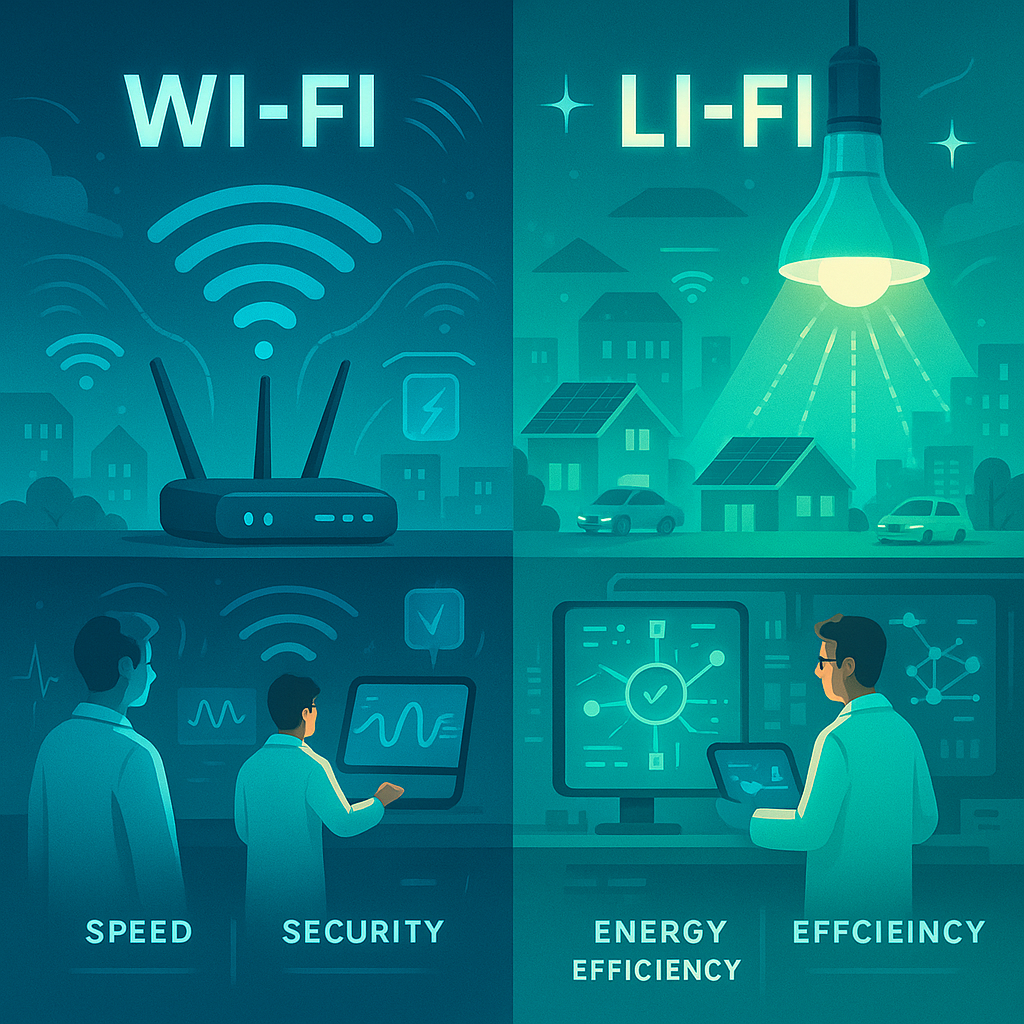Wireless tech plays a big role in our daily lives — we stream videos, send emails, and control smart home gadgets with it. For years, Wi-Fi has been our go-to choice, but now a new speedier option is turning heads: Li-Fi.
This blog breaks down the key points about Li-Fi vs. Wi-Fi in plain language. It’s perfect if you’re an engineer, a tech fan, or just want to learn about the future of wireless communication.
📶 What Is Wi-Fi and How Does It Work?
Wi-Fi means Wireless Fidelity. It’s the go-to tech we use to get our devices online without wires. It does this by sending data through radio waves. Your gadget — be it your phone, computer, or TV — picks up these signals to create a wireless internet link.
- Speed: Wi-Fi can hit pretty good speeds (with newer routers).
- Range: It works through walls and covers big areas.
- Use Case: It’s perfect for homes, workplaces, coffee shops, and public spots.
Wi-Fi is a hit because it’s easy to use and works with almost every device out there.
💡 What Is Li-Fi and How Is It Different?
Li-Fi, which stands for Light Fidelity, offers a fresh approach to data transmission. Unlike traditional methods, it harnesses light waves – LED lights – to send information at breakneck speeds.
Picture this: if a lamp could flicker millions of times in a second (too quick for your eyes to catch), those flickers could carry data. This concept forms the basis of Li-Fi.
- Speed: It outpaces Wi-Fi by a long shot – reaching up to 100 Gbps.
- Medium: It relies on visible or infrared light.
- Use Case: It shines in environments where security and speed are top priorities such as hospitals, planes, or research facilities.
⚖️ Key Differences Between Li-Fi and Wi-Fi
Here’s a quick look at how these two technologies stack up:
FeatureWi-FiLi-FiSignal TypeRadio wavesLight waves (visible or infrared)SpeedUp to 10 Gbps100 Gbps or more (in theory)CoverageWorks through walls and barriersMust have a clear path to workSecurityOthers can intercept from a distanceHigh security (light stays put)InterferenceOther RF devices affect itNo RF interferencePractical UseHomes, offices public areasHospitals, planes industrial sites
🧠 Why Engineers Are Excited About Li-Fi
Li-Fi may seem like something straight out of a sci-fi movie, but researchers are already testing and using it in real-life situations. Here’s why developers and engineers find it exciting:
🏥 1. Perfect for Sensitive Areas
Li-Fi doesn’t use radio waves, so it won’t mess with equipment in hospitals or planes.
🔐 2. Super-Secure Communication
Li-Fi can’t go through walls, so the signal stays in one room — making it tough to hack or intercept.
⚙️ 3. Fast Data Transfer
Engineers working with big data transfers or real-time systems can take advantage of its super-fast speed.
🚧 Challenges of Using Li-Fi
Li-Fi shows great promise, but it has a few drawbacks to consider:
- Needs Light to Work: Without light, you lose the signal. It doesn’t function in darkness or when something blocks the light.
- Limited Range: It can’t penetrate walls, so its coverage stops at the room’s edge unless you set up multiple Li-Fi systems.
- Still Evolving: It hasn’t caught up to Wi-Fi in terms of availability or support yet.
Despite these issues, researchers are tackling them, and combining Li-Fi with Wi-Fi might be the way forward.
🔮 What the Future Looks Like
As smart tech and more industries advance, Li-Fi might become the go-to for fast safe data sharing. It probably won’t kick Wi-Fi to the curb anytime soon, but it could team up with it to boost performance in specific areas.
Picture homes with both Wi-Fi and Li-Fi — where your gadgets switch to the best choice on their own, depending on what you’re up to.
